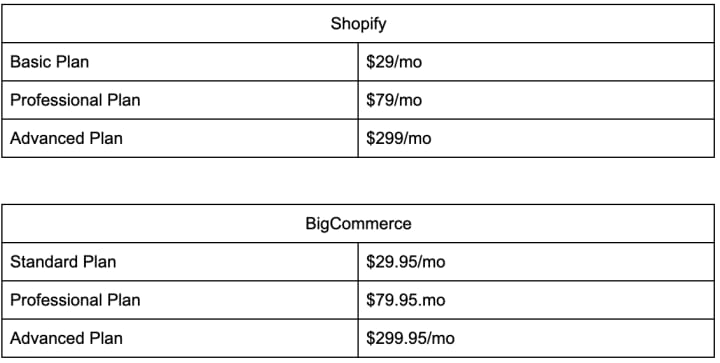BigCommerce vs. Shopify: Which is Right for Your E-commerce Business?
To help you make an informed decision, we’re here to provide you with a straightforward and detailed comparison between two of the most popular eCommerce platforms: BigCommerce and Shopify.

Choosing the right e-commerce platform for your business is vital. When you’re launching an online business, getting started on the right platform can be the difference between leaping in the black versus getting stuck in the red.
Before you invest, it’s important to know which platform is right for your individual business. To help you make an informed decision, we’re here to provide you with a straightforward and detailed comparison between two of the most popular eCommerce platforms: BigCommerce and Shopify.
What Exactly Are BigCommerce and Shopify?
As an entrepreneur, your business is your priority. It’s no wonder then that so many business owners just aren’t sure what eCommerce platforms like Shopify and BigCommerce are. To put it simply, they are one-stop-shops for setting up an online business.
They are designed to highlight and sell your products and process payments. Think of them like store with a built-in or transaction system.
In the world of DIY e-commerce sites, both BigCommerce and Shopify are top contenders. They both allow you to create a digital storefront using templates, inventory systems, and payment systems, including tax set up and shipping. Furthermore, both process billions of dollars in transactions, offer scalability, and are extremely stable and reliable.
Deciding between which system is best for your business comes down to your individual needs, budget, and projected sales.
Which is Right For You: BigCommerce vs. Shopify
E-commerce systems save you time, money, and energy by making creating an online shop easy. Of course, this comes with a cost. Additionally, while BigCommerce and Shopify may seem nearly identical, there are some differences in how user-friendly they are and what options you get for your money.
Ease of Use
When it comes to an intuitive design and ease of use, Shopify takes this category. Their set up process is one of the easiest we’ve seen. Their page builder and all its tools are also brilliantly designed with users in mind. You can drag and drop elements, preview fonts and colors, and fully customize your page quickly, in real-time.
Not interested in going over-the-top with your online store’s design? That’s ok. The beauty of using Shopify is that you can customize as much or as little as you want depending on which theme you’re working with.
BigCommerce’s user interface is also easy to use but can be a little more involved when it comes to customizing the appearance of your store. And, we hate to say it, BigCommerce’s page builder feels a little more outdated. The Shopify “Getting Started” system is a bit more complex, but for a good reason!

The BigCommerce App vs. Shopify App
When it comes to managing your online store and processing orders via mobile, the Shopify app is the better choice. Shopify’s app offers more capabilities and options, yet has fewer bugs. It is also overall easier to use. Most users appreciate being able to see how their business is doing at-a-glance and connect to other selling platforms effortlessly through the Shopify App.
Add-On Apps and Features
Want to upgrade your e-commerce shop’s design or view greater analytics? There’s an app for that. Shopify and BigCommerce both have optional plug-ins and app add-ons that can improve your sales and the aesthetic of your website. Shopify, having been around longer, has more plug-ins and more apps, though.
BigCommerce does have some comparable apps and plug-ins, but Shopify’s offerings are simply more diverse.
Shopify vs. BigCommerce Templates and Themes
Your website is the face of your e-commerce business; and your store’s aesthetic affects your sales. Like a brick-and-mortar, you’re selling ambiance, a brand, and an idea along with your products. So, being able to hit the right notes matters when it comes to designing your shop. With an e-commerce system, you build your shop’s appearance through templates and themes. Luckily, both Shopify and BigCommerce have invested their time in creating modern and diverse templates and themes.
A template is a premade layout, and a theme is a common style of elements designed for websites.
When it comes to numbers, Shopify and BigCommerce are about equal. Both have a wide array of free templates and themes. They both also have some excellent premium templates and themes you can pay for. Their prices are comparable on paid templates.
So, where do the differences lie? Shopify’s templates are easier to sort through. They’re organized by industry type, and they have a useful filter that allows you to narrow your options quicker. You can find the best Shopify themes for your needs within seconds of browsing.
BigCommerce offers more high-end themes for high-end prices. These elegant themes run between $200 and $300 to use, but they can add a more tailored feel to your shop.
Finally, BigCommerce templates allow you to customize the layout and elements to a higher degree than Shopify. This can make a template look and feel more like your own creation. For many shops, BigCommerce templates’ customization means more than being boxed-in to even the best Shopify themes and Shopify templates.

Additional Features
Want to explore all the features available to make the most of an online shop? When it comes to built-in features, these platforms are comparable. They both have built-in SEO tools, marketing tools, cross-platform integrations, social media sales integration, and seamless POS.
Shopify offers a wider range of features through third-party vendors. BigCommerce’s third-party apps do cover the features most people want when it comes to better understanding their customers and sales.
Here’s How Their Most Popular Features Compare
Shopify vs. BigCommerce

BigCommerce vs. Shopify: Prices and Fees
If you’re a start-up, you don’t want to go broke just getting up and running. You also don’t want to drive customers elsewhere with an unattractive online shop or hard to use shopper interface. So, when it comes to prices and fees, we encourage you to think about value and your shop’s needs.
Plans and Fees

Both e-commerce platforms come with monthly fees for all plans. Shopify and BigCommerce both have an option for customized advanced plans as well. As you look at these prices, you’ll notice they are very similar. BigCommerce’s plans come with unlimited data storage for the Professional and Advanced plans and with 3 GB of data for the Standard Plan. None of Shopify’s plans offer unlimited data, and the Basic Plan includes 1 GB.
Fees
When you begin looking at the fees, it’s easier to see how these e-commerce platforms compare, value-wise.
Credit Card Fees

Transaction Fees
One of the biggest advantages of BigCommerce is that they use their own payment processing system, so their users do not pay transaction fees in addition to credit card fees. This can add up to a lot of savings. Shopify charges between .5% for Advanced to 2% for their Basic Plan.
Domain Name Prices
Shopify lets you own your domain name for $9 per year. You can also connect an existing GoDaddy domain name to your Shopify account. BigCommerce charges $12 annually.
Sales Limits: BigCommerce vs. Shopify
When it comes to scalability and making money, it can be difficult to accept a cap on your sales. For most new businesses, these caps feel irrelevant since they are so high. With BigCommerce, the Standard Plan limits your sales at $50,000 per year. The Plus Plan jumps to $180,000 per year, and the Pro Plan lets you sell up to $400,000 each year. Shopify does not have sales caps.
Other Cost Factors
Many businesses find they have to purchase add-ons and third-party apps to have full functionality of their Shopify store. These add-ons can really add up. Whereas, most businesses on BigCommerce tend to be happy with the control and features built into the platform.
Choosing the Best for Your Needs
How Do You Plan to Access the Platform Long-Term?
If you’re always on the go and heavily rely on a smartphone to do business, the Shopify App makes Shopify a better choice for your needs.
What and Where Are You Selling?

Both Shopify and BigCommerce have their perks.
If you have a brick-and-mortar store or you have plans for opening one in the future, Shopify better transitions to a physical POS system.
For international business and customers, BigCommerce’s built-in currency converter is a no-brainer.
If you sell products with a wide array of styles, sizes, colors, and designs, you’re better off with BigCommerce since they allow you more menus for your customers to choose from as they select a product. Additionally, their side-by-side product comparison tool and their in-store search options can help your customers find what they need more easily. Easier shopping often equates to more sales.
Do Your Products Lend Themselves to Upsells?
If you sell products that can be paired or lend themselves to upsells, Shopify’s 1-click upsell tool is perfect for you.
Shopify vs. BigCommerce: E-Commerce Built for You
When it comes to your business, you know what you need better than anyone else. If you’re still unsure which e-commerce platform is right for you, explore Shopify and BigCommerce better through their 14-day free trials. Get hands-on, take notes, and remember to cancel whichever you decide is not the best for your business. Remember that they often hope to hook you by having you invest your time into building an online shop—don’t get trapped by the sunk cost fallacy.
No matter which you choose, when it comes to BigCommerce vs. Shopify, you can’t go wrong. So, get out there and sell, sell, sell.
About the Creator
Seller's Choice
Seller’s Choice is a digital marketing solution provider dedicated to the interests, growth, and profitability of e-commerce brands.






Comments
There are no comments for this story
Be the first to respond and start the conversation.